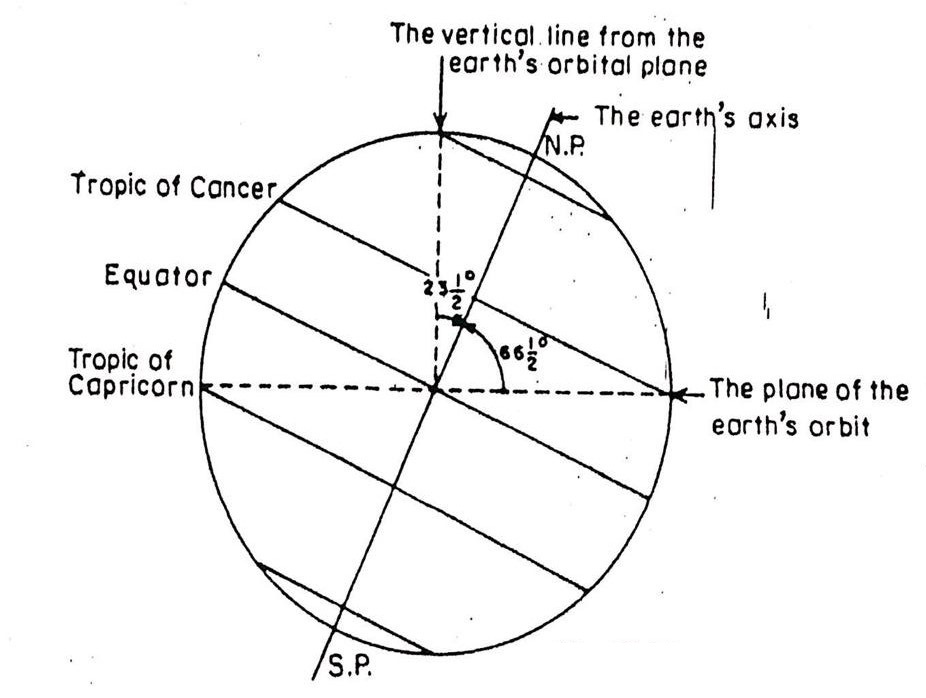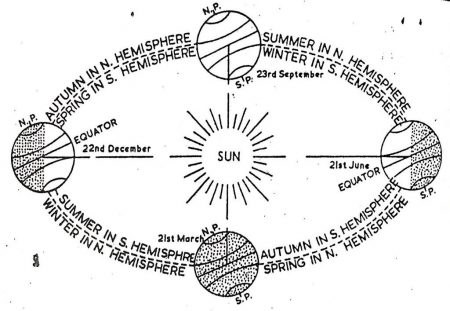Motions of the Earth 01/06/2019 – Posted in: NCERT
MOTIONS OF THE EARTH
TERMS THAT YOU MUST KNOWRotation: The spinning of the earth on its axis completing one circle in about twenty four hours. Revolution: Motion of the earth around the sun completing one revolution in about 365 days and 6 hours. Tropic of Cancer: An imaginary circle on the earth’s surface in Northern Hemisphere at an angular distance of 23.5 degree from the equator. Tropic of Capricon: An imaginary circle on the earth’s surface in the Southern Northern Hemisphere at an angular distance of 23.5 degree from the equator. Arctic Circle: An imaginary circle on the earth’s surface in Northern Hemisphere at an angular distance of 66.5 degree from the equator. Antartic Circle: An imaginary circle on the earth’s surface in Southern Hemisphere at an angular distance of 66.5 degree from the equator. |
The earth, like other planets has two motions. It spins continuously on its axis once in about twenty-four hours, which is called Rotation. The earth’s axis is titled at an angle of 23.5 degree from a perpendicular to the orbital plane. This tilting of the earth’s axis is referred to as the Inclination of Earth’s axis.
The northern and the southern points on the earth through which this axis passes, are known as the North Pole and the South Pole respectively.
While rotating on its axis, the earth also moves round the sun at a speed of about 100,000 kilometer per hour. It completes one circle in about 365 days and 6 hours. This annual motion of the earth is called Revolution.
Rotation
The earth receives its light and heat from the sun. When the earth rotates on its axis, one half of it, facing the sun, is lit. The other half remains is darkness. Thus each part of the earth’s surface comes into the sunlight for a certain period and then turns away from it in 24 hours.
The sun appears to move in the sky from east to west. Actually it is not the sun but the earth which moves.
Revolution
While rotating on its axis, the earth also moves round the sun. The earth completes one revolution in about 365 days and 6 hours. For the sake of our convenience, we consider a year as consisting of only 365 days, and ignore 6 hours. Thus in four years the difference becomes as much as 24 hours or one day. Hence, every fourth year we add one day to the year. The year to which one day is added has 366 days and it is called a Leap Year. The extra day is added to the month of February, making the number of days in this month 29 instead of 28.
On its path around the sun, the earth’s axis always remains inclined to one side. Because of this constant inclination in one direction, the Northern Hemisphere remains inclined towards the sun or faces the sun during one half of the year. Therefore, a larger part of this hemisphere receives sunlight. Every point in this hemisphere takes a longer time to go out of sunlight, with the result that the days are longer. In contrast, the Southern Hemisphere is away from the sun. It, therefore, has shorter days and longer nights. During the other half of the year, the Southern Hemisphere is inclined towards the sun. Hence, it has longer days and shorter nights.
The Cycle of the Season
| The days and nights and change in the seasons because of the rotation and revolution of the earth. |
This figure shows four positions of the earth, each at an interval of about three months. These dues are more or less fixed. In all these positions, the axis of the earth makes an angle of 66 ½ Degree with the plane of its orbit. The direction of its inclination always remains the same.
21 June
The North Pole inclined towards the sun, while the South Pole is away from it. The rays of the sun are falling vertically not on the equator but on 23 ½ Degree north of it, on the Tropic of Cancer.
The greater part of the Northern Hemisphere is receiving the rays of the sun. Here the days are longer, nights shorter and the rays of the sun at noon are vertical. It receives more than it loses.
Therefore, it is having the summer season.
In comparison, the rays of the sun are slanting in the Southern Hemisphere. A relatively small part of this hemisphere is receiving the sun’s rays. Hence, days are shorter and nights are longer. This is the winter season in the Southern Hemisphere.
02 December
It is the Southern hemisphere which is now inclined towards the sun, while the Northern Hemisphere is away from it. The vertical rays of the sun are now falling vertically on places at 23 ½ Degree south of the equator, i.e., the Tropic of Capricorn. The days are longer and the nights are shorter in the Southern Hemisphere. It is, therefore, summer in the Southern Hemisphere and winter in the Northern Hemisphere.
23 September and 21 March
On 23 September and 21 March the rays of the sun fall vertically on the equator at noon. Both the poles receive the rays of the sun. As a result, exactly one half portion of each hemisphere receives the sun’s rays, making day and night equal all over the world on these two days.
23 September
On 23 September, it is the autumn season in the Northern Hemisphere and the spring season in the Southern Hemisphere. The opposite is the case on 21 March, when it is spring in the Northern Hemisphere and autumn in the Southern Hemisphere.
Source: NCERT
You can follow us on LinkedIn and for more updates related to UPSC IAS Preparation, Like our Facebook Page and subscribe our Diligent IAS Youtube Channel



